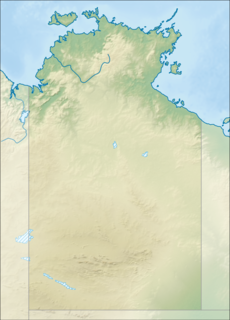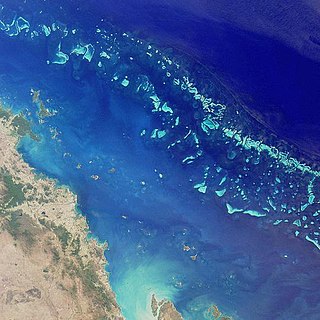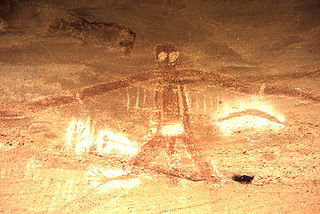Related Research Articles

Watarrka National Park is a protected area in the Northern Territory of Australia located about 1,316 kilometres south of the territory capital of Darwin and 323 kilometres southwest of Alice Springs.

A listed building, or listed structure, is one that has been placed on one of the four statutory lists maintained by Historic England in England, Historic Environment Scotland in Scotland, Cadw in Wales, and the Northern Ireland Environment Agency in Northern Ireland.

Kalkarindji is a town and locality in the Northern Territory of Australia, located on the Buntine Highway about 554 kilometres (344 mi) south of the territory capital of Darwin and located about 460 kilometres (290 mi) south of the municipal seat in Katherine.
The Register of the National Estate was a heritage register that listed natural and cultural heritage places in Australia that was closed in 2007. Phasing out began in 2003, when the Australian National Heritage List and the Commonwealth Heritage List were created and by 2007 the Register had been replaced by these and various state and territory heritage registers.

Munga-Thirri—Simpson Desert Conservation Park is a protected area located in the Australian state of South Australia about 970 kilometres (600 mi) north of the state capital of Adelaide and above 215 kilometres (134 mi) north-east of the town of Oodnadatta.

The Australian National Heritage List or National Heritage List (NHL) is a heritage register, a list of national heritage places deemed to be of outstanding heritage significance to Australia, established in 2003. The list includes natural and historic places, including those of cultural significance to Indigenous Australians such as Aboriginal Australian sacred sites. Having been assessed against a set list of criteria, once a place is put on the National Heritage List, the provisions of the Environment Protection and Biodiversity Conservation Act 1999 apply.

The Environment Protection and Biodiversity Conservation Act 1999, long title An Act relating to the protection of the environment and the conservation of biodiversity, and for related purposes, is an Act of the Parliament of Australia that provides a framework for protection of the Australian environment, including its biodiversity and its natural and culturally significant places. Enacted on 17 July 2000, it established a range of processes to help protect and promote the recovery of threatened species and ecological communities, and preserve significant places from decline. The EPBC Act is as of June 2020 administered by the Department of Agriculture, Water and the Environment. Lists of threatened species are drawn up under the Act, and these lists, the primary reference to threatened species in Australia, are available online through the Species Profile and Threats Database (SPRAT).
The Gazetteer of Australia is an index or dictionary of the location and spelling of geographical names across Australia. Geographic names include towns, suburbs and roads, plus geographical features such as hills, rivers, and lakes.

An Australian Aboriginal sacred site is a place deemed significant and meaningful by Aboriginal Australians based on their beliefs. It may include any feature in the landscape, and in coastal areas, these may lie underwater. The site's status is derived from an association with some aspect of social and cultural tradition, which is related to ancestral beings, collectively known as Dreamtime, who created both physical and social aspects of the world. The site may have its access restricted based on gender, clan or other Aboriginal grouping, or other factors.

The Commonwealth Heritage List is a heritage register established in 2003, which lists places under the control of the Australian government, on land or in waters directly owned by the Crown. Such places must have importance in relation to the natural or historic heritage of Australia, including those of cultural significance to Indigenous Australians. National heritage sites on the list are protected by the Environment Protection and Biodiversity Conservation Act 1999.
Australian heritage laws exist at the National (Commonwealth) level, and at each of Australian Capital Territory, New South Wales, Northern Territory, Queensland, South Australia, Tasmania, Victoria, Western Australia State and Territory levels. Generally there are separate laws governing Aboriginal cultural heritage and sacred sites, and historical heritage. State laws also allow heritage to be protected through local government regulations, such as planning schemes, as well.
The Australasian Underwater Cultural Heritage Database (AUCHD) is an online, searchable database containing data on shipwrecks, aircraft that have been submerged underwater or wrecked on the shore, and other artefacts of cultural significance which are or have been underwater. It includes what used to be called the Australian National Shipwreck Database (ANSDB), originally developed by the Australasian Institute of Maritime Archaeology in December 2009, now significantly expanded to include other objects. The database was hosted and maintained by the Department of the Environment and Energy until the environment functions of that department, including AUCHD, were taken over by the Department of Agriculture, Water and the Environment on 1 February 2020.
The Australian Heritage Places Inventory (AHPI) was an online database of information about Australian places listed in State, Territory and Commonwealth Heritage Registers. The database was supported by the Heritage, Reef and Marine Division of the Department of Agriculture, Water and the Environment, which withdrew support of the database in 2020, and the database was taken down.

The Historic Shipwrecks Act 1976 was an Australian Act of Parliament designed to legally protect historic shipwrecks and any relics or artefacts from those wrecks. The Act automatically affects all shipwrecks that meet the "historic" criteria and are in Australian Commonwealth waters : complementary state and territory legislation protects shipwrecks in state and territory waters including rivers and bays. Of the estimated 8,000 shipwrecks in Australian waters, more than 6,500 are protected under this legislation.

Daguragu, previously also known as Wattie Creek by the Gurindji people, is a locality in the Northern Territory of Australia located about 551 kilometres (342 mi) south of the territory capital of Darwin and located about 460 kilometres (290 mi) south-west of the municipal seat in Katherine. Daguragu community is situated on Aboriginal land held under perpetual title.
The Department of the Environment and Energy (DEE) was an Australian government department in existence between 2016 and 2020.

The Tennant Creek Telegraph Station is an historical site about 16 kilometres north of Tennant Creek in the Northern Territory of Australia.

Ryan Well Historical Reserve, formerly Reserve No. 1343, is a protected area in the Northern Territory of Australia located in the locality of Anmatjere about 129 kilometres (80 mi) north of Alice Springs.

John Flynn's Grave Historical Reserve, more commonly referred to as Flynn's Grave is the grave site of John Flynn who was an Australian Presbyterian minister who founded the Australian Inland Mission (AIM) and founding the Royal Flying Doctor Service. The grave, which is now a historical reserve, is located at the base of Mount Gillen on Larapinta Drive in the Alice Springs suburb of Flynn.
References
- 1 2 "Heritage Register". Northern Territory Government . Retrieved 19 February 2017.